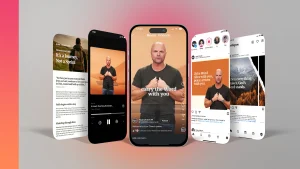In a world where technology touches every part of our lives, it’s no surprise that churches can use it to grow and connect with their communities. Church growth strategies often focus on building a welcoming space, but in today’s digital age, expanding your congregation takes more than just opening doors. Digital tools have become crucial for reaching new members and keeping current ones engaged. From social media to online services, these tools can make a huge difference in how your church interacts with people. So, how can your church harness these strategies to grow? This post explores practical and effective digital approaches to nurture and expand your congregation. Let’s dive into how embracing technology can transform your community engagement and outreach, making your church a vibrant hub of connection and faith.
Understanding Church Growth Strategies
Church growth strategies are the blueprints for expanding your congregation. In an age where everyone is looking for a connection, these strategies ensure that your church doesn’t just survive but thrives. They’re essential not only because they help bring new faces through your doors but also because they keep your mission alive and kicking. Let’s break it down and see why these strategies are the backbone of any growing church.
The Importance of Growth Strategies
Why do churches even need growth strategies? First off, they’re crucial for staying relevant. Without them, a church may feel like it’s still living in a time capsule. They help your congregation connect with the modern world, ensuring that your message reaches new ears.
Here are a few things to consider regarding their importance:
-
Relevance: In a fast-paced, ever-changing world, strategies help you stay in touch with the community’s needs and trends.
-
Attracting new members: Just like any community, a church thrives on fresh perspectives. Growth strategies are like a welcome mat, inviting newcomers in.
-
Sustaining the mission: Your core beliefs and mission are the heart of your church. Strategies ensure that you have the resources and energy to keep your mission alive.
Have you ever thought about what makes a tree so strong? It’s the roots. Growth strategies are like those roots, providing the stability needed to branch out and reach the sky.
Types of Growth Strategies
Not all growth is about numbers. In fact, there are different kinds of growth that a church can pursue to spread its influence and strengthen its community:
-
Numerical Growth: This is what most people think of first. How can we get more people to come on Sundays? It’s not just about filling the pews. It’s about building a bigger family.
-
Spiritual Growth: This focuses on deepening the faith of existing members. It’s like watering a plant. The richer the soil, the stronger the plant. Spiritual growth ensures that each member’s faith is nurtured and grows over time.
-
Community Impact: This is all about making a difference beyond the church walls. How is the church impacting its neighborhood or city? Is your church a beacon of hope in the community? This strategy enhances your church’s role as a community leader and support system.
When you look at these strategies side by side, it’s clear that they each bring something unique to the table. Together, they form a diverse mix that can help a church thrive in any environment. Whether you’re focusing on numbers, faith, or community engagement, each strategy plays a part in painting the bigger picture of church growth.
So, where does your church want to grow next?
Digital Tools for Effective Outreach
In today’s tech-driven world, churches have an abundance of digital tools at their fingertips to reach out and grow their congregations. These tools can help bridge the gap between traditional ministry and the online landscape, making it easier to connect with both existing and potential members. By integrating these digital strategies, you can enhance your church’s growth strategies and create a vibrant, engaged community.
Social Media Engagement
Social media platforms such as Facebook, Instagram, and Twitter are more than just places to post photos or updates; they are vibrant communities where conversations happen and connections are made. Imagine these platforms as your church’s digital front porch where you can welcome new visitors and keep current members in the loop.
-
Facebook: Create a church page to share inspirational content, event updates, and livestream services. Encourage members to comment and share posts to increase visibility.
-
Instagram: Use visuals to tell your church’s story. Share photos and short videos that highlight community events or worship moments to engage younger demographics.
-
Twitter: Keep followers informed with quick updates and thought-provoking quotes. Use hashtags to join larger conversations and increase your reach.
By maintaining an active presence on these platforms, churches can foster a sense of belonging and involvement beyond Sunday services.
Website Optimization
Your church’s website is more than just a virtual bulletin board; it is the cornerstone of your digital presence. A well-designed website can be a powerful tool in your church’s growth strategies, offering a window into your community and values.
-
User-Friendly Design: Ensure your site is easy to navigate. Simple menus and clear categories help visitors find what they’re looking for without frustration.
-
Essential Information: Make sure service times, locations, and contact information are prominently displayed. Visitors shouldn’t have to hunt for basic details.
-
Dynamic Content: Regularly update your website with blog posts, event calendars, and sermon recordings. Keeping content fresh encourages repeat visits and deeper engagement.
A website that is both attractive and informative can leave a lasting impression, often serving as the first point of contact for newcomers.
Email Marketing Campaigns
While social media is great for quick interactions, email remains a powerful tool for more direct and personal communication. Think of it as sending a thoughtful letter to your congregation’s digital mailbox.
-
Newsletters: Share stories of community impact, spiritual reflections, and future plans. This keeps everyone on the same page and builds a sense of shared purpose.
-
Event Announcements: Targeted emails can inform specific groups about upcoming events, ensuring nobody misses out on important gatherings.
-
Personalized Messages: Use email to connect on a personal level by sending birthday greetings or follow-ups with those who have visited recently.
By crafting thoughtful email campaigns, you can nurture relationships and encourage active participation in church life.
Embracing these digital tools not only broadens your reach but also strengthens the bonds within your community, making them essential components in your church’s growth strategies.
Building Community through Digital Platforms
In an age where technology connects us, churches can harness digital tools to foster genuine community and growth. Embracing these platforms doesn’t just expand reach—it nurtures deep bonds among members. As part of Church Growth Strategies, leveraging online resources helps break the barriers of geography and time, creating opportunities for spiritual enrichment.
Online Bible Studies and Prayer Groups
Imagine sitting in a cozy room with friends, sharing insights, and lifting each other up. Now, picture doing this from the comfort of your home with members scattered across cities or even countries. Online Bible studies and prayer groups make it possible. These virtual gatherings are essential for spiritual growth and accountability. They allow members to meet regularly, ensuring everyone stays connected and spiritually fed.
-
Accessibility: No matter where members are, they can join in. A smartphone or computer is all it takes to step into a space for worship and learning.
-
Flexibility: With busy schedules, having the option to attend a group at a convenient time is invaluable. Evening or morning, the door is always open.
-
Inclusivity: Online groups bring together diverse perspectives, enriching discussions and deepening understanding.
Digital platforms like Zoom, Google Meet, or Facebook Groups can serve as virtual sanctuaries where fellowship flourishes. They provide a space where people can be vulnerable and supported, a crucial element in any church community.
Creating a Virtual Welcome Experience
First impressions matter, and the same applies to a church’s digital footprint. Creating an inviting online experience for newcomers is like rolling out the red carpet. It sets the tone for what they can expect and ensures they feel embraced from the start.
-
Online Welcome Services: Host a live-streamed service specifically for new visitors. This can include a brief overview of the church’s mission, worship style, and community activities.
-
Virtual Orientation Sessions: Offer sessions where newcomers can learn about the church’s history, meet leaders, and discover opportunities to get involved. These can be live or pre-recorded, giving flexibility.
-
Interactive Content: Engage visitors with interactive quizzes or introduction videos. Include testimonials from regular members sharing why they chose your church.
Creating this digital welcome mat not only offers a warm greeting but also ensures new visitors have all the information they need to feel at home. It’s like inviting someone into your living room and offering them a warm cup of tea—simple, yet impactful in building lasting relationships.
Leveraging Data for Growth
In the era of digital transformation, understanding and utilizing data has become crucial for church growth strategies. By tapping into data analytics, churches can gain valuable insights into their congregation, making it easier to tailor strategies to meet their unique needs. Let’s explore how you can analyze attendance trends and gather feedback to drive growth.
Understanding Attendance Trends
Analyzing attendance data is like having a map for your church’s journey toward growth. Do you know where your congregation is peaking or where it’s thinning out? Tracking attendance trends can uncover vital patterns and areas needing attention. Here’s how you can dive into this:
-
Regular Monitoring: Set up a system to track weekly or monthly attendance. Use this data to identify patterns over time. Is there a specific season or event that draws more people? Are there weekends when attendance dips?
-
Visual Tools: Utilize graphs and charts to visualize trends. They make it easier to spot those peaks and valleys in attendance. This visual clarity helps in planning and resource allocation.
-
Comparative Analysis: Compare current attendance with previous years. Are numbers improving, stagnating, or declining? Understanding the “why” behind these shifts can guide future decisions.
-
Data Segmentation: Break down data by demographics, if possible. Knowing who attends services most often—whether it’s families, young adults, or seniors—can inform targeted outreach initiatives.
Analyzing these trends is like adjusting the sails on a ship; it helps you navigate toward growth more efficiently.
Surveying Congregants for Feedback
Imagine trying to bake a cake without knowing if your guests prefer chocolate or vanilla. Similarly, growing a church requires understanding what your congregation needs and desires. Surveys are a straightforward way to gather this feedback.
-
Design Simple Surveys: Create surveys that are easy to fill out. Ask clear questions about the services, activities, and overall experience. What do they love? What could be improved?
-
Utilize Multiple Channels: Offer physical surveys in church and digital options via email or church apps. This ensures you reach as many members as possible.
-
Encourage Honest Feedback: Assure members their feedback is valued and will be used to enhance their experience. People are more likely to participate if they know their voices matter.
-
Analyze Results: Look for common themes or suggestions. This data can highlight gaps or potential areas for improvement, like adding more community events or expanding youth programs.
-
Act on Feedback: Share survey results with the congregation and explain how their input will shape future changes. This transparency builds trust and encourages ongoing engagement.
Surveys act as a compass, guiding your church to meet its congregation’s needs more effectively. By listening and responding, you foster a community where everyone feels heard and valued.
Incorporating these strategies into your church growth plan can harness the power of data, driving not just numbers, but meaningful connections within your congregation.
Embracing Digital Tools
In our interconnected world, embracing digital tools isn’t just a suggestion for church growth—it’s a necessity. Churches seeking to expand their congregation and foster community will find technology to be a trusted ally.
Key Points Recap
Let’s take a moment to revisit the essential strategies that can set your church on a path to growth:
-
Embrace Online Presence: A well-designed website and active social media profiles are more than just digital outposts—they’re your church’s welcoming front door to the world.
-
Utilize Streaming Services: Broadcasting services online allows those unable to attend in person to still partake in worship. It’s like sending a warm invitation to everyone’s living room.
-
Implement Digital Giving: Providing online donation options makes supporting your church easier and more convenient, paving the way for increased funding and outreach possibilities.
-
Foster Community with Apps: Mobile apps encourage engagement, offering resources, event updates, and a sense of belonging at congregants’ fingertips.
Encouragement for Future Growth
The road ahead is paved with opportunities for churches willing to step into the digital arena. Think of technology as a bridge, connecting people not only with each other but with your church’s mission. By embracing these digital tools, you’re not just keeping up—you’re setting the stage for a vibrant and committed congregation.
Why not start today? Explore these strategies, adapt them to your church’s unique vision, and watch as your community grows both in numbers and in spirit. After all, isn’t growth about more than just gathering people—it’s about changing lives.





